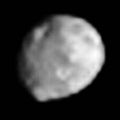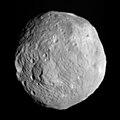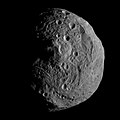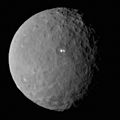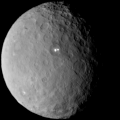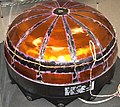Dawn (space probe)
| Dawn | |||||||||||||||||||||||||||||||
|---|---|---|---|---|---|---|---|---|---|---|---|---|---|---|---|---|---|---|---|---|---|---|---|---|---|---|---|---|---|---|---|
 Dawn in the asteroid belt (artist's impression) |
|||||||||||||||||||||||||||||||
| NSSDC ID | 2007-043A | ||||||||||||||||||||||||||||||
| Mission goal | Asteroid Vesta , dwarf planet Ceres . |
||||||||||||||||||||||||||||||
| Client |
|
||||||||||||||||||||||||||||||
| Launcher | Delta II 7925 Heavy | ||||||||||||||||||||||||||||||
| construction | |||||||||||||||||||||||||||||||
| Takeoff mass | 1108 kg | ||||||||||||||||||||||||||||||
| Course of the mission | |||||||||||||||||||||||||||||||
| Start date | September 27, 2007, 11:34 UTC | ||||||||||||||||||||||||||||||
| launch pad | Cape Canaveral , LC-17B | ||||||||||||||||||||||||||||||
|
|||||||||||||||||||||||||||||||
| Mission logo | |||||||||||||||||||||||||||||||

|
|||||||||||||||||||||||||||||||
The space probe Dawn ( English for dawn ) of the NASA Discovery program was launched on September 27, 2007. It orbited and explored the asteroid Vesta and the dwarf planet Ceres between 2011 and 2018 . The name Dawn stands for the goal of obtaining information about the early history of the solar system by being the first probe to visit the objects of the asteroid belt , which are regarded as very original . It was the first mission in which a probe entered orbit on two different celestial bodies.
The mission was led by the Jet Propulsion Laboratory (JPL), while the scientific project lead was at the University of California . NASA put the total cost at US $ 357.5 million. Of this, $ 281.7 million was spent on the development and construction of the probe and $ 75.8 million in flight operations for the primary mission through July 2015.
planning
As part of the Discovery program, Dawn and Kepler were selected from various possible projects in 2001 . Both missions should start in 2006.
In November 2005, the preparation of the mission was stopped by the JPL. The cause was cost overruns in the manufacture of the probe. At the beginning of 2006 it should be decided whether the mission will be continued with a later start date or whether it will be canceled entirely. Since the launch window for the probe was unusually long at more than a year, the mission could be launched until October 2007.
On March 3, 2006, it was announced that the Dawn mission had been canceled. The space probe, which was largely completed, was to be put into storage. However, the head of NASA Michael Griffin announced shortly thereafter that the cancellation of the mission was currently under review. Just three weeks later, on March 27, NASA announced that the Dawn program had resumed.
Mission history
Preparations and start
The probe, built by Orbital Sciences , was originally planned to launch in July 2007 with a Delta II rocket. A solar panel wing was damaged by a falling tool on June 11, 2007 while preparing to launch, but it could be repaired without jeopardizing the schedule.
Dawn is on the upper level of their Delta II Heavy lifting
View along a solar panel for Dawn
However, the launch was postponed by three months for other reasons and the probe, which had already been mounted on the launch vehicle, was removed and stored. On September 27, 2007 at 11:34 UTC , the spacecraft Dawn, which had been mounted on the rocket, was successfully launched from launch pad 17B of Cape Canaveral Air Force Station .
Flight through the inner solar system and swing-by on Mars
In the first 81 days after takeoff, ground control checked Dawn and the instruments. After a precise interplanetary orbit determination , the probe began on December 17, 2007 to operate one of the three NSTAR ion thrusters in continuous mode in order to change the flight path to a transition path to Mars. After about 85% of this orbit ellipse had passed through outside the Earth's orbit , Dawn carried out a swing-by maneuver on Mars on February 17, 2009 in order to reach a higher speed and an orbit further from the Sun for the flight to Vesta. There were also some recordings from Mars.
Asteroid Vesta
From May 2011, Dawn delivered the first recordings of Vesta . At this point in time, the images were only used to navigate the probe and were not yet optimized in terms of sharpness and resolution.
On July 16, 2011, Dawn swerved into an orbit around Vesta with a radius of about 16,000 kilometers. After that, the orbit radius was gradually reduced further. In early August, an orbit was reached at an altitude of 2,700 kilometers, in which the first images and scientific data could be collected. From this height, the composition of the surface was determined with the help of spectroscopic investigations. The height of the orbit was then lowered to just under 680 kilometers above the surface. In this orbit Vesta's surface was mapped and topographical data was collected using stereo images. Then the altitude was lowered even further to 200 kilometers. At this height, the composition of the surface was analyzed more precisely using the Gamma Ray / Neutron Spectrometer . When the probe began to move away from Vesta in the spring of 2012, it paused briefly in an orbit of 2,700 kilometers to collect data. The angle of the sun's rays had changed so that the scientists could observe previously hidden details and surface structures from different angles.
The originally planned duration of the Vesta mission was extended in April 2012 by NASA by forty days, initially until August 26, 2012. Due to the failure of a reaction wheel , the departure from Vesta had to be postponed until September. Dawn is equipped with four reaction wheels, of which at least three must normally work. After a first reaction wheel failed in June 2010, new software was installed that enabled operation with only two reaction wheels with the aid of the hydrazine engines, so that the failure of this second wheel could not endanger the further course of the mission.
Ceres
On September 5, 2012, Dawn left Vesta's orbit on a transfer orbit to the dwarf planet Ceres . This orbit was created by almost continuous thrust from the ion drive and led to an approx. 10% greater distance from the sun.
On March 6, 2015, the Dawn probe entered a very high orbit around the dwarf planet Ceres, which was then gradually lowered to carry out scientific tasks. The primary mission consisted of the first mapping of the surface from a high Ceres orbit and ended in July 2015. NASA approved funding for the follow-up mission in early July 2016. A visit to the asteroid (145) Adeona was originally discussed as a possible follow-up mission , but with the defective reaction wheels it was not certain whether Dawn would make it to there in a usable condition. Instead, the observation of Ceres continued.
From July to December 2015, Dawn approached the surface in several spiral steps up to 380 km; this enabled a second mapping with a resolution of 40 meters per pixel. This secondary mission, which also served to record the soil chemistry in detail, ended at the end of June 2016. From September 2, 2016, the orbit was increased again to 1,460 km in order to reduce hydrazine consumption. The probe was now roughly at the same height as it was when it was first mapped, but the observation was now made from a different perspective. From November to December, the orbit was enlarged further to 7,200 km in order to repeat the previous measurements and thus obtain more precise data. The gamma ray and neutron spectrometers, which previously examined the surface, now examined the cosmic radiation in order to be able to include the background radiation in the calculations and to calibrate the data.
In February 2017, Dawn was in a highly elliptical orbit at an altitude between 7,520 km and 9,350 km and changed from February 23 to an altitude of 20,000 km and another orbital plane, this also allowed new perspectives. In the spring the sun was directly behind the probe in opposition, so that Ceres had the highest radiation, it was hoped that this would provide additional information about the nature of the dwarf planet.
On April 24, 2017, the third reaction wheel failed. The last remaining reaction wheel was then deactivated and the probe only used hydrazine for position control. The modified software for attitude control in "hybrid mode" was installed in April 2011, which can control the probe with two reaction wheels together with the hydrazine nozzles. The flight paths and observation plans were modified so that the control nozzles were minimally in operation, which increased the range of the hydrazine reserves. The software was also prepared for the failure of the last reaction wheels, so that no changes to the observation plan or software modification were necessary.
At the beginning of June 2018, it was lowered to an elliptical orbit with a height of only 50 km to allow an even more precise observation of the Ceres surface. The ion thrusters operated for the last time on June 21, 2018 and were then deactivated forever. The low orbit caused a high consumption of hydrazine and was therefore moved to the final phase.
Occator crater with the bright zones Cerealia Facula in the middle and Vinalia Faculae on the right side
Animated flyover
End of mission
On November 1, 2018, the mission was declared over after a final attempt at contact had failed. The hydrazine supplies were exhausted, causing the position control to fail and the power supply to collapse. Dawn will remain in orbit around Ceres for decades.
technology
The main body of the Dawn spacecraft is a bus that is 1.36 m high and, with fully deployed solar panels, has a wingspan of 19.7 m. The take-off mass was 1108 kg, 624 kg of which was empty.
The probe has three NSTAR ion thrusters with a specific pulse of 3,000 s, the predecessor of which was already tested on the Deep Space 1 mission . The engines used xenon as supporting mass and were used for interplanetary transfers as cruise engines used. The probe carried 425 kg of xenon (450 kg were originally planned). The three 30 cm engines could be swiveled in two axes, so they could also be used for position control. Only one of the three engines could ever work. While Deep Space's engine was in use for 1,678 days, 2,100 days of operation were scheduled for this mission. The ion thrusters went into operation for the first time on October 6, 2007 and were in good condition to the end. They were in operation for a total of 2,141 days, that is 5.87 years and 53% of the duration of the mission and caused a total speed change of 41,360 km / h, which is more than any other spaceship achieved with its own power. When the ion thrusters were shut down, according to the calculation, 261 of the 270 liters of xenon were used up. In contrast, conventional hydrazine- powered propulsion systems were used to pivot into the orbits around the heavenly bodies .
Since the ion drive requires a lot of electrical energy, the probe has large solar panels that deliver 10 kW of power close to the earth, at Ceres one calculated another 1 kW. In the original design, four-segment solar panels were provided, but in the course of development they were changed to five-segment ones with 25% more solar cell surface and thus 25% more power.
The probe has three low gain antennas and one high gain antenna with a diameter of 152 cm for communication. The low gain antennas enable communication at low data rates as long as the high gain antenna is not pointing towards the earth, but only one of the three can be in operation at a time. The probe has two small deep-space transponders , a three-kilogram component that was used and tested for the first time with Deep Space 1 . This compact and reliable transmitter could receive and transmit in the X-band. Two traveling wave tubes with 100 W transmission power were used with the high gain antenna, only one of the two could be in operation at a time. The data rate reached up to 124 kilobit / s.
Instruments
Existing instruments
Three scientific instruments are integrated on Dawn:
- Framing Camera (FC)
- For reasons of redundancy, Dawn has two identical cameras that are primarily used to map the asteroids. The multispectral recordings of the cameras also allow the geological composition of the surface to be studied. Another area of application for the cameras is the optical navigation of the probe using star fields. Each camera weighs around five kilograms and requires around 18 watts of power. The cameras were built by the Max Planck Institute for Solar System Research in cooperation with the German Aerospace Center (DLR) and the Institute for Data Technology and Communication Networks (IDA) at the Technical University of Braunschweig .
- Visible and IR Spectrometer (Mapping Spectrometer (MS), internal 'VIR')
- VIR is a spectrometer that works in visible and infrared light. VIR is based on the VIRTIS instrument of the Venus Express mission and was provided by the Italian space agency ASI .
- Gamma Ray / Neutron Spectrometer (GR / NS, internal 'GRAND')
- The gamma-ray / neutron spectrometer maps the occurrence of main elements such as oxygen , silicon , iron , titanium , magnesium , aluminum , calcium and trace elements such as uranium , thorium , potassium , hydrogen , gadolinium and samarium . The Gamma Ray / Neutron Spectrometer can detect the presence of hydrogen to determine the level of hydration on the asteroid's surface. The instrument was provided by the US Department of Energy's Los Alamos National Laboratory .
Crossed instruments
Another two instruments were removed from the final design of the probe:
- Magnetometer (mag)
- The magnetometer should look for weak magnetic fields near the asteroids. The instrument would have been attached to a five-meter boom. Mag was provided by the University of California, Los Angeles , but was removed from the final design of the probe for weight reasons.
- Laser Altimeter (GLA)
- The laser altimeter was to create topographic maps of the asteroids and would be supplied by NASA's Goddard Space Flight Center . The large number of recordings from different directions can be evaluated stereoscopically in order to derive height information from them.
Others
Until November 4, 2006, NASA gave interested parties the opportunity to post their name on a website so that it could be written on a microchip that was flying in the spacecraft. Around 365,000 names were registered in this Internet campaign “Send your name to the Asteroid Belt”.
A space probe to the asteroid Vesta was already being planned in the mid-1980s. This Russian-French cooperation was called VESTA and was supposed to continue the successful cooperation with the VEGA probes. The start was planned for 1991/92. However, due to various factors, this mission was discontinued in the late 1980s.
In March 2016, the Dawn team of NASA and JPL received the Collier Trophy to the National Aeronautic Association .
See also
- List of space probes
- Lucy - NASA planned mission to research several Jupiter Trojans
- OSIRIS-REx - NASA sample-return mission to the asteroid (101955) Bennu
- Rosetta - ESA mission to comet 67P / Churyumov – Gerasimenko
- DESTINY + - JAXA mission to the asteroid (3200) Phaethon
Web links
- Dawn Blog Comprehensive reports from the JPL
- Dawn Homepage of the MPS (German)
- Dawn Homepage at JPL (English)
- Dawn Mission Page at NASA (English)
- Detailed description of the Dawn mission from Bernd Leitenberger
- Virtual 3D flyover of Vesta (English)
Individual evidence
- ↑ NASA (ed.): Dawn Launch, Mission to Vesta and Ceres. Press kit . September 2007 ( nasa.gov [PDF]).
- ↑ Susan Reichley: 2001 News Releases - JPL Asteroid Mission Gets Thumbs Up from NASA. In: www.jpl.nasa.gov. Retrieved August 13, 2016 .
- ↑ Space.com: NASA Dawn Asteroid Mission Told To 'Stand Down' , November 7, 2005.
- ^ Spaceflightnow.com: Probe built to visit asteroids killed in budget snarl , March 3, 2006.
- ↑ Planetary Society: A slight reprieve for Dawn ( Memento June 16, 2008 in the Internet Archive ), March 8, 2006.
- ↑ NASA: NASA Reinstates the Dawn Mission , March 27, 2006.
- ↑ Spaceflight Now: Dawn asteroid probe won't launch until September 7th, 2007 (English).
- ↑ NASA: Dawn Spacecraft Successfully Launched , September 27, 2007 (English).
- ↑ Dawn Journal: http://dawn.jpl.nasa.gov/mission/journal_12_17_07.asp .
- ↑ NASA's Dawn Captures First Image of Nearing Asteroid ( July 21, 2011 memento in the Internet Archive ) dawn.jpl.nasa.gov, accessed May 13, 2011.
- ↑ "DAWN" shoots the first image from Vesta derstandard.at.
- ↑ NASA's Dawn Spacecraft Enters Orbit Around Asteroid Vesta www.jpl.nasa.gov, accessed July 17, 2011.
- ↑ Dawn Nears Start of Year-Long Stay at Giant Asteroid. Accessed July 12, 2018 .
- ↑ Mission News: Dawn Gets Extra Time to Explore Vesta www.nasa.gov, accessed April 19, 2012.
- ↑ a b NASA's Dawn Spacecraft Hits Snag on Trip to 2 Asteroids. Retrieved August 27, 2012 .
- ↑ Editor: DAWN: Probe in orbit around the dwarf planet Ceres. Press release from the German Aerospace Center. astronews.com, March 6, 2015, accessed March 7, 2015 .
- ↑ NASA Jet Propulsion Laboratory Blog | Dear Exdawnsions. Retrieved November 4, 2018 .
- ↑ NASA Jet Propulsion Laboratory Blog | Mission Accomplished But the Journey Continues ... Retrieved November 4, 2018 .
- ^ Dawn Sets Course for Higher Orbit. Jet Propulsion Laboratory, August 31, 2016, accessed March 21, 2017 .
- ^ New Ceres Views as Dawn Moves Higher. Jet Propulsion Laboratory, November 18, 2016, accessed March 21, 2017 .
- ^ Dawn Discovers Evidence for Organic Material on Ceres. Jet Propulsion Laboratory, February 16, 2017, accessed March 21, 2017 .
- ↑ Dawn Mission | Dawn Journal on April 25, 2017. Retrieved May 21, 2017 .
- ↑ Dawn Mission | Dawn Journal May 24, 2017. Retrieved May 27, 2017 .
- ↑ JPL: Dawn Mission: New Orbit, New Opportunities. May 31, 2018, accessed June 5, 2018 .
- ↑ JPL: NASA's Dawn Mission to Asteroid Belt Comes to End. November 1, 2018, accessed November 3, 2018 .
- ↑ Tony Greicius: Dawn's engines Complete Firing, Science Continues . In: NASA . June 28, 2018 ( nasa.gov [accessed July 7, 2018]).
- ↑ Dawn at Vesta - Press Kit / July 2011. NASA, July 2011, p. 20 , accessed on March 27, 2017 (English).
- ↑ Jim Taylor: Dawn Communications . Ed .: NASA. August 2009 ( nasa.gov [PDF]).
- ↑ NSSDC Master Catalog Display: Framing Camera (FC) .
- ↑ NSSDC Master Catalog Display: Mapping Spectrometer (MS) .
- ↑ NSSDC Master Catalog Display: Gamma Ray / Neutron Spectrometer (GR / NS) .
- ↑ NSSDC Master Catalog Display: Magnetometer (Mag) .
- ↑ Space Files: Pre-Dawn: The French-Soviet VESTA mission ( Memento from May 5, 2013 on WebCite ), November 5, 2007.







